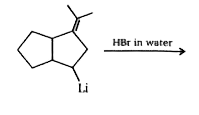In Which of the following reaction an acid-base reaction takes place ?
A

B

C

D
All of these
Video Solution
Text Solution
The correct Answer is:D
All reactions are between Grignard reagent and the reagents having .H. or .D.
all are acid-base reactions.
|
Updated on:21/07/2023
Similar Questions
Which of the following is possible acid base reaction?
View SolutionWhich of the following reactions takes place at anode ?
View SolutionWhich of the following species formed in acid base reactions can act as Bronsted buses as well as Bronsted acids?
View SolutionIn which of the following reaction formation of reaction intermediate does not take place?
View SolutionWhich of the following reactions does not take place?
View SolutionWhich of the following reactions does not take place?
View SolutionWhich of the following reactions does not take place?
View SolutionWhich of the following reaction does not take place ?
View SolutionWhich of the following Diels− Alder reactions do not take place ?
View SolutionWhich of the following reactions take place by SN2 reaction?
View Solution


